| |
a web page by Don Roberson |
ASIAN BARBETS Megalaimidae |
- 34 species in south and southeastern Asia
- DR personal total: 20 species (58%), 5 photo'd
|
The
Asian barbets are chunky, mostly mid-sized, often colorful, and vocal
birds of the Oriental tropics. These barbets hard to see but easy to
hear — their calls can dominate the aural landscape.

Watch and listen to Rita's video of this male using its gular sac to produce its territorial call via this link, or click on
Rita's video-cap photo to the right |
|
Among
them are a highly-sought endemics. There are 9 barbets on Borneo, but 3
are endemics in the mountains. Despite two trips and hearing all three,
I've managed to see just one — the striking Golden-naped Barbet (left and below).

In 2003 my wife Rita Carratello obtained video of a territorial Golden-naped on Mt. Kinabalu showing a male vibrated a bulging air-sac on its neck when it gave its strident, hollow took-took-tarrroook
calls over and over again. This behavior, recalling the neck sacs of
booming grouse, was seemingly overlook in the literature (e.g., Short
& Horne 2002) until Lim et al. (2009) published an illustrated
paper on this behavior in Blue-eared Barbet Megalaima pulcherrima, and Rita and I published our observations of this Golden-naped Barbet (Roberson & Carratello 2009). |
|
| |
|
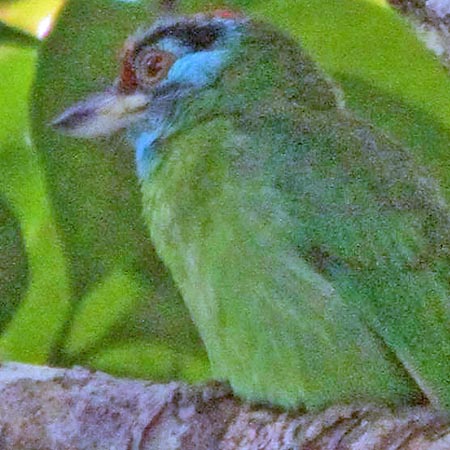 The perched Blue-throated Barbet
(above) is so still and matches the foliage so well that it illustrates
just how hard many Asian Barbets can be to locate in the canopy — even
if you know the "right" part of the tree to search. It may then require
a scope to see all the complicated color patterns on the head (right —
sam photo enlarged). A very small yellow patch above the red forecrown
helps to identify this as the nominate race of Blue-throated Barbet The perched Blue-throated Barbet
(above) is so still and matches the foliage so well that it illustrates
just how hard many Asian Barbets can be to locate in the canopy — even
if you know the "right" part of the tree to search. It may then require
a scope to see all the complicated color patterns on the head (right —
sam photo enlarged). A very small yellow patch above the red forecrown
helps to identify this as the nominate race of Blue-throated Barbet
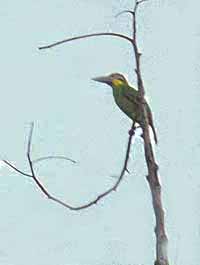 There are some larger, big-billed species, such as Gold-whiskered Barbet (left), that do occasionally perch atop a bare snag — but I've only seen these at quite a distance (as here in Sumatra). There are some larger, big-billed species, such as Gold-whiskered Barbet (left), that do occasionally perch atop a bare snag — but I've only seen these at quite a distance (as here in Sumatra).
The Great Barbet Psilopogon virens
of the Himalayan forests is much larger than others in this family. At
273 grams it is more than 7 times heavier than the Crimson-throated
Barbet P. rubricapilla of Sri Lanka. |
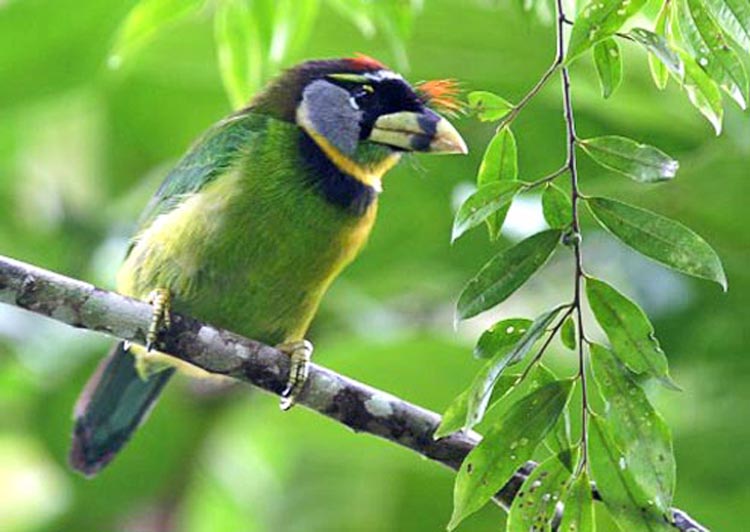
Another large and spectacular barbet is Fire-tufted Barbet P. pyrolophus
of Malaya and Sumatra (left in a fabulous shot by Hideo Tani).
Fire-tufted Barbet is a striking bird that has a vague resemblance to
Toucan-Barbet of the New World. It is quite distinct from other Asian
barbets by its graduated tail and its facial bristles in distinct nasal
tufts. |
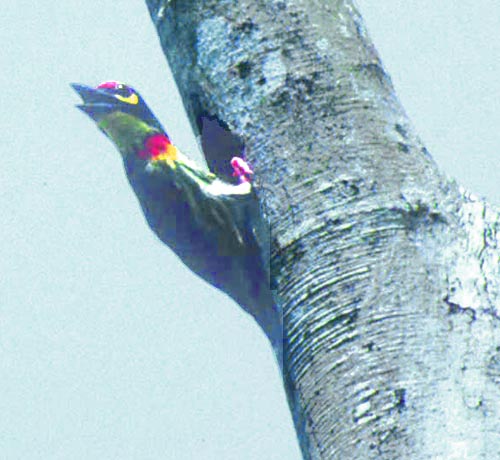 The call of the Coppersmith Barbet
(right; at a nest hole), for example, is a dominant sound of Asian
woodlands. In some tracts of woods the "hammering" sound of these
barbets (thought to recall a coppersmith at his trade) is present dawn
to dusk. Nest holes, like this one, are excavated in rotten trees. The
2-5 eggs will be incubated for about two weeks; thereafter both parents
care for the young. The zygodactyl feet (two toes forward, two
backward) are adapted for clinging to trees, like woodpeckers, but
unlike them the tail feathers are not stiffened. Coppersmith Barbet is
by far the most widely distributed Asian barbet, occurring from India
to Indonesia and the Philippines. It is also the only non-forest barbet
in Asia. The call of the Coppersmith Barbet
(right; at a nest hole), for example, is a dominant sound of Asian
woodlands. In some tracts of woods the "hammering" sound of these
barbets (thought to recall a coppersmith at his trade) is present dawn
to dusk. Nest holes, like this one, are excavated in rotten trees. The
2-5 eggs will be incubated for about two weeks; thereafter both parents
care for the young. The zygodactyl feet (two toes forward, two
backward) are adapted for clinging to trees, like woodpeckers, but
unlike them the tail feathers are not stiffened. Coppersmith Barbet is
by far the most widely distributed Asian barbet, occurring from India
to Indonesia and the Philippines. It is also the only non-forest barbet
in Asia.
Recent molecular studies (den Tex &
Leonard 2014) found that Coppersmith Barbet occurs in two
well-differentiated and allopatrically distributed color morphs: a
red-headed and a yellow-headed form (the photo is of a red-morph type
in the Philippines). The red morphs formed two clades within the
diversity of yellow ones. The study suggests that the species
originated in SE Asia/Sundaland and then colonized the Philippines from
the south in the mid-Pleistocene, via a now-extinct population on
Borneo. More recently, Coppersmith Barbets colonized India and Sri
Lanka. They were also likely distributed on the Malay Peninsula but
went extinct there too. The population that now inhabits that region is
a natural re-colonization of yellow-morph birds about 80 years ago. As
a "red morph evolved at least twice independently from yellow morphs in
the late Pleistocene, it seems that this change does not require very
many mutational steps, and thus can arise relatively frequently, on an
evolutionary timescale" (den Tex & Leonard 2014). |
 At one time all but two of the Asian barbets are consigned to the genus Megalaima. Recent molecular research showed that genus Psilopogon was embedded within the clade, and it had priority. Now, all but two species are assigned to that genus Psilopogon. The one shown here (right) is Brown-headed Barbet of the Indian subcontinent. At one time all but two of the Asian barbets are consigned to the genus Megalaima. Recent molecular research showed that genus Psilopogon was embedded within the clade, and it had priority. Now, all but two species are assigned to that genus Psilopogon. The one shown here (right) is Brown-headed Barbet of the Indian subcontinent.
The exceptions are Brown Barbet Calorhamphus fuliginosus of Borneo and Sooty Barbet C. hayii
of the Malay Peninsula and Sumatra. Both are dull-colored, uniformly
brown species that nests colonially; it also lacks the vocal repertoire
of boops and trills of other Asian barbets, giving only a wheezy
whistle (Short & Horne 2001). Prum (1988) and Barker & Lanyon
(2000) initially found that molecular evidence did not group Brown
Barbet with other Asian barbets. Short & Horne (2002) used with
evidence as a "major stumbling block for those who would recognize
three barbet families, one for each continent" (see below). But Moyle
(2004) used three different molecular methods and undertook three
different types of analysis, and showed flaws in the early studies. A
mis-choice of analytical methods (e.g., parsimony alone) has the
tendency "to unite taxa on long branches even when not closely
related." It appears that Brown Barbet does, indeed, group with other
Asian barbets, thus removing the "stumbling block" to our family
arrangement here. |
| The
remaining Asian barbets require tracts of extensive habitat, from
jungle to swamps, and pristine forests from steaming lowlands to
montane cloud forests. Asian barbets are important components of the
tropical forests of the Orient. They provide, in good measure, the
"sound track" of these jungles. They widely disperse seeds and pollen
as they eat fruit, catkins, and flowers, and their used nesting holes
can be used by other creatures. Tropical barbets are decline with the
loss of lowland and montane forests. Of particular concern for barbets
is the intensity of the human need for dead wood, the removal of which
eliminates nesting sites. Even selective logging in southern Asia
removes host trees of strangling fits, and thus the figs themselves, a
primary barbet food (Short & Horne 2002). Pressure from the
cage-bird trade is another problem in some areas; Fire-tufted Barbet is
a particularly desired. We can only hope that the Asian barbets and
their diversity will survive man's pressure on their habitats. Here
(below) is a Lineated Barbet in his habitat — a lowland forest in southern Asia. |
|
| |
Photos: Rita Carratello videotaped the vocalizing Golden-naped Barbet Psilopogon pulcherrima in July 2003 on Mt. Kinabalu, Sabah, Borneo; I took the photo (of a different bird) that same day. The Blue-throated Barbet P. asiatica was at Kaeng Krachan NP, Thailand, on 23 Dec 2012. The Gold-whiskered Barbet P. chrysopogon at was at Ketambe, w. Sumatra, Indonesia, on 18 Aug 1988. Hideo Tani photographed the Fire-tufted Barbet P. pyrolophus at Frasers Hill, Malaysia, in Feb 2003. The Coppersmith Barbet P. haemacephala was was at its nest hole near Bislig, Mindanao, Philippines, in March 1990.. The Brown-headed Barbet P. zeylanica was at Ramnagar, Uttar Pradesh, India, on 13 Mar 2001. The Lineated Barbet P. lineatus was at Wat Khao Look Chang, Thailand, on 24 Dec 2012.
Photos © Don Roberson and Hideo Tani, as credited; used with permission, all rights reserved.
Photos of over 4000 species by Hideo Tani can be seen on his web site.
Family Book: Rating: 
Short, L. L., and J.F.M. Horne. 2001. Toucans, Barbets, and Honeyguides. Oxford Univ. Press, Oxford.
I
confess that I don't own this book, nor have I done more that quickly
glance through it in a bookstore. Yet every one of the Oxford
University Press series on bird families has been excellent, and this
looks equally solid. I presume that the "meat" of this book has been
summarized by the same authors in their Handbook of the Birds of the World
series (Short & Horne 2002) which I do own and have studied.
Consistent with Oxford books in this series, the introductory material
is extensive and the species accounts thorough. Plates and
illustrations enliven and enhance the text. If I have any quibble, it
is with the conservative approach to family level taxonomy but, then
again, this was written before the molecular studies by Johansson et
al. (2001) and Moyle (2004).
Literature cited:
- Barker,
F.K., and S.M. Lanyon. 2000. The impact of parsimony weighting schemes
on inferred relationships among toucans and Neotropical barbets (Aves:
Piciformes). Mol. Phylog. Evol. 15: 215-234.
- Burton,
P.J.K. 1984. Anatomy and evolution of the feeding apparatus in the
avian orders Coraciiformes and Piciformes. Bull. Brit. Mus. (Nat.
Hist.) 47: 331-441.
- den Tex, R-J., and J.A. Leonard. 2014. The phylogeography of red and yellow coppersmith barbets (Aves: Megalaima haemacephala). Front. Ecol. Evol. fevo.2014.00016; doi: 10.3389
- Johansson,
U.S., T.J. Parsons, M. Irestedt, and P.G.P. Ericson. 2001. Clades
within "higher land birds," evaluated by nuclear DNA sequences. J.
Zool. Syst. Evol. Research 39: 37-51
- Lanyon, S.M., and J.G. Hall. 1994. Re-examination of barbet monophyly using mitochondrial-DNA sequence data. Auk 111: 389-397.
- Lim, A.T.H., L.K. Wang, and Y.C. Wee. 2009. The Blue-eared Barbet Megalaima australis and its gular sac. Birding Asia 11: 98-101.
- Moyle,
R.G. 2004. Phylogenetics of barbets (Aves: Piciformes) based on nuclear
and mitochondrial DNA sequence data. Mol. Phylog. Evol. 30: 187-200.
- Prum,
R.O. 1988. Phylogenetic interrelationships of the barbets (Aves:
Capitonidae) and toucans (Aves: Ramphastidae) based on morphology with
comparisons to DNA-DNA hybridization. Zool. J. Linnaean Soc. 92:
313-343.
- Roberson, D., and R. Carratello. 2009. Gular sac use by Golden-naped Barbet. Birding Asia 12: 13.
- Short, L.L., and J.F.M. Horne. 2002. Family Capitonidae (Barbets), pp. 140-219 in Del Hoyo, J. Elliott, A., & Sargatal, J. eds. Handbook of the Birds of the World. Lynx Edicions, Barcelona.
|
|
|


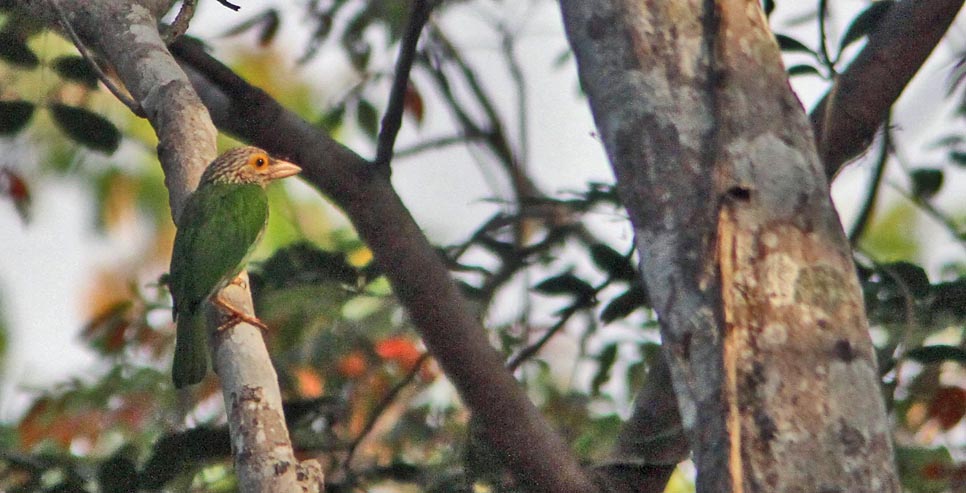


 The perched Blue-throated Barbet
(above) is so still and matches the foliage so well that it illustrates
just how hard many Asian Barbets can be to locate in the canopy — even
if you know the "right" part of the tree to search. It may then require
a scope to see all the complicated color patterns on the head (right —
sam photo enlarged). A very small yellow patch above the red forecrown
helps to identify this as the nominate race of Blue-throated Barbet
The perched Blue-throated Barbet
(above) is so still and matches the foliage so well that it illustrates
just how hard many Asian Barbets can be to locate in the canopy — even
if you know the "right" part of the tree to search. It may then require
a scope to see all the complicated color patterns on the head (right —
sam photo enlarged). A very small yellow patch above the red forecrown
helps to identify this as the nominate race of Blue-throated Barbet  There are some larger, big-billed species, such as Gold-whiskered Barbet (left), that do occasionally perch atop a bare snag — but I've only seen these at quite a distance (as here in Sumatra).
There are some larger, big-billed species, such as Gold-whiskered Barbet (left), that do occasionally perch atop a bare snag — but I've only seen these at quite a distance (as here in Sumatra). 
 The call of the Coppersmith Barbet
(right; at a nest hole), for example, is a dominant sound of Asian
woodlands. In some tracts of woods the "hammering" sound of these
barbets (thought to recall a coppersmith at his trade) is present dawn
to dusk. Nest holes, like this one, are excavated in rotten trees. The
2-5 eggs will be incubated for about two weeks; thereafter both parents
care for the young. The zygodactyl feet (two toes forward, two
backward) are adapted for clinging to trees, like woodpeckers, but
unlike them the tail feathers are not stiffened. Coppersmith Barbet is
by far the most widely distributed Asian barbet, occurring from India
to Indonesia and the Philippines. It is also the only non-forest barbet
in Asia.
The call of the Coppersmith Barbet
(right; at a nest hole), for example, is a dominant sound of Asian
woodlands. In some tracts of woods the "hammering" sound of these
barbets (thought to recall a coppersmith at his trade) is present dawn
to dusk. Nest holes, like this one, are excavated in rotten trees. The
2-5 eggs will be incubated for about two weeks; thereafter both parents
care for the young. The zygodactyl feet (two toes forward, two
backward) are adapted for clinging to trees, like woodpeckers, but
unlike them the tail feathers are not stiffened. Coppersmith Barbet is
by far the most widely distributed Asian barbet, occurring from India
to Indonesia and the Philippines. It is also the only non-forest barbet
in Asia. At one time all but two of the Asian barbets are consigned to the genus Megalaima. Recent molecular research showed that genus Psilopogon was embedded within the clade, and it had priority. Now, all but two species are assigned to that genus Psilopogon. The one shown here (right) is Brown-headed Barbet of the Indian subcontinent.
At one time all but two of the Asian barbets are consigned to the genus Megalaima. Recent molecular research showed that genus Psilopogon was embedded within the clade, and it had priority. Now, all but two species are assigned to that genus Psilopogon. The one shown here (right) is Brown-headed Barbet of the Indian subcontinent.